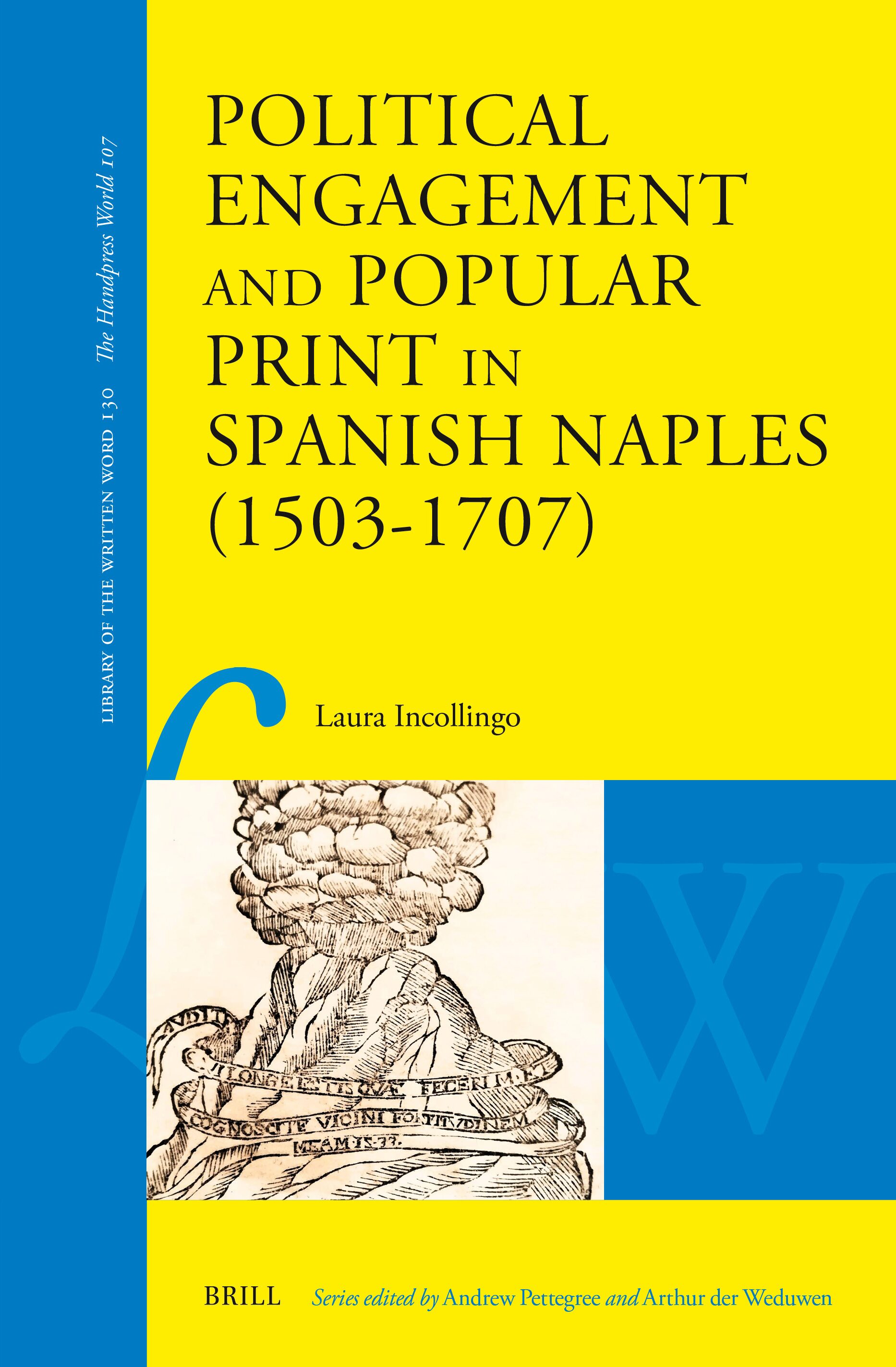


Reviewer Domenico Cecere - Università di Napoli Federico II
CitationIn recent years, scholars interested in the history of Naples and Southern Italy have repeatedly called for a systematic investigation of political communication, in dialogue with the most recent advances in research on the public sphere between the sixteenth and the early eighteenth century. While several medium- and large-sized urban centres in early modern Italy and Europe have been the focus of extensive study, Naples – both a capital of the Spanish Monarchy and one of the most populous cities of the Mediterranean – has remained conspicuously marginal to these developments. The most reliable and comprehensive works on the history of books, publishing and information in the Mezzogiorno have rarely engaged with new international historiographical trends, either because they were published mostly in Italian or because they adhered to rather traditional methodological approaches, that left unexamined a constellation of informal communicative practices beyond the book trade and official channels of communication.
Laura Incollingo’s monograph makes a significant contribution to this historiographical landscape, by offering a systematic reconstruction of the book and news market, analysed through the interpretive lenses of propaganda and popular consumption of information and opinion. The book explores the role of cheap, ephemeral print – such as books, broadsheets, pamphlets, newspapers, and engravings – in building a political relationship between the people of Naples and the political and religious authorities during the two centuries in which the Kingdom formed part of the Spanish Monarchy (ca. 1503-1707). It examines what was published in Naples, what people were expected to read, and how this cultural production contributed to shape the «public opinion».
The book is organised into five chapters. The first examines the institutional framework and economic conditions of the Neapolitan book trade, investigates the social and political role of the printers’ and booksellers’ association and the professional rivalries among its leading members, thus showing the extent to which the business relied on the relationship between «clients and patrons».
The second and fifth chapters are devoted to the analysis of long-term dynamics, respectively, of the relationships between print and State, and between print and the Church. On the one hand, the author examines the instruments of political control and ecclesiastical censorship over what was printed and disseminated in the city; on the other, she scrutinises the content of books and pamphlets – concerning military victories, marriages, funerals, as well as the devotional print production – arguing that they were designed to display the political harmony and social prosperity of the city of Naples, its devotion to the Spanish crown and its adherence to the principles of the Catholic orthodoxy. These sections of the book show how news was priced and circulated in public life: Incollingo contends that both governmental and ecclesiastical authorities recognised cheap print as the most efficient means of communicating with their subjects and influencing public opinion.
Instead, the third and the fourth chapter focus on periods of acute political and social unrest, provoked by the revolt of 1647 and by various calamities. The analysis of diverse sources – manuscripts, pamphlets, official broadsheets, placards posted on the city walls, etc. – offers abundant evidence of a cohesive and coordinated propagandistic effort, as «both the government and the would-be agitators were very well aware of the huge impact of popular print as a medium capable of conveying […] political messages» (p. 91). Furthermore, the analysis reveals that all parties involved understood the importance of monitoring what circulated in the streets, and of countering the spread of manipulated news that might favour their adversaries.
At the end of this investigation – which is supplemented by an appendix that provides valuable information on key Neapolitan printers and booksellers active in the seventeenth century – the author challenges the long-standing view that Naples lacked a vibrant printing culture, demonstrating instead that it possessed a thriving and dynamic print industry deeply embedded in civic, religious, and political life. She shows that both the Spanish government and the Church were aware they could not control the news market just through repression and censorship, thus they employed print as an instrument of political persuasion and public engagement, particularly during times of crisis.
The book has several indisputable strengths. First, it synthesises the results of previous research little known to an international academic audience, reinterprets them in an original way, and provides both a new analytical framework and valuable insights from unpublished sources. Another strength lies in its comparative approach, made possible above all by the careful and systematic use of the USTC, an invaluable bibliographic resource. This has enabled the author to identify rare or little-known books or pamphlets, determine the number of editions of a given text, estimate its success among readers, and detect similarities between works printed in Naples and elsewhere. In doing so, the study aligns with, and at times challenges, broader historiographical debates on the configuration of the early modern public sphere. It situates Naples within the wider ‘information revolutionʼ mapped by scholars for other European contexts, while also pointing out the specificity of the Neapolitan case. Not only does the book interrogate the mechanisms of print-mediated political communication under Spanish rule, but also extends into media history by integrating ephemeral and extra-market forms of information circulation.
The use of unpublished sources is particularly effective in the sections devoted to the legal framework and to relations between the printing industry and both State and Church authorities. Here, the author gains valuable insights into the economic and social dimensions of the book trade, the relationships between printers/booksellers and the city government, the licensing system, and, more broadly, the power relations that shaped the printing business. In other sections, however, the study of archival and manuscript materials yields mainly fragmentary clues: for example, when considering the reading practices of different social strata, observations on how news and cheap books were understood and by whom they were read, rest largely on conjecture or on analogies with other cases.
Of course, a work of such scope and ambition cannot be exhaustive; inevitably, it leaves some issues unexplored and raises new questions that incite further research. In some instances, the analysis of political and social dynamics remains at a relatively superficial level. The decision to employ clear-cut, monolithic categories such as «Spanish rulers» and «the people of Naples» as analytical lenses limits the exploration of the fault lines between the various political and social entities, and within each group – the rival factions of the aristocracy, the diverse world of Italian and Spanish officials and bureaucrats, the municipal government with its persistent internal tensions, the guilds and confraternities, etc., and the various bodies and factions within the Church – and also obscures the alliances forged between some of these groups. A deeper understanding of certain contexts or background information – for example, of the forms of control over the urban territory during the revolt of 1647 (p. 112), or of the competition between religious orders, particularly between the Theatines and the Jesuits in the aftermath of the plague of 1656 (p. 181) – might have allowed the author to offer different or more comprehensive interpretations of some of the texts considered.
It is also regrettable that such an innovative and extensive research underestimates certain key strands of historiography, especially Italian, or that it misrepresents their findings. This is a missed opportunity for a fruitful scholarly dialogue that could have further enhanced the study’s results. For instance, the book gives insufficient consideration to recent Italian work on popular culture, which it criticises – among other points – for focusing excessively on the oral dimension and for «failing to acknowledge the reality of the intermingling between oral and written culture.» Moreover, it perhaps overstates the particularities of the «Italian academy» and its separation from Anglo-American approach to cultural history, which is said to have achieved more notable results in the study of cheap print and popular reading. Equally debatable is the author’s understanding of some important strands of historical research on the Kingdom of Naples. It is difficult to agree with the claim that «for Italian traditional historians the narrative that prevails is still that promoted by Galasso, who characterised the Spanish centuries as a period of repression and cultural desolation» (p. 12), given that the Spanish black legend – challenged by Benedetto Croce as early as the early twentieth century – has had little influence on the most significant studies of the last six decades. It is similarly hard to agree with the view that «historians have largely ignored the role of public festivals organised by the Spanish court as an effective tool for bridging the gap between Spaniards and Neapolitans and building a more interwoven community» (p. 81), considering the many and valuable works by Italian, Spanish and English-speaking historians on these topics over the last thirty years.
Nonetheless, these points of criticism should not overshadow the many strengths of the book and the insights it offers to the academic community. It provides an up-to-date and accurate picture of publishing activity in Naples, engages with new international historiographical trends, opens promising avenues for further research, and raises fresh questions on topics long considered settled.